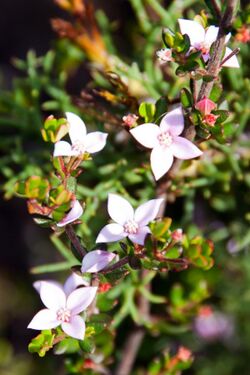Biology:Boronia edwardsii
| Island boronia | |
|---|---|

| |
| Boronia edwardsii near Rocky River on Kangaroo Island | |
| Scientific classification | |
| Kingdom: | Plantae |
| Clade: | Tracheophytes |
| Clade: | Angiosperms |
| Clade: | Eudicots |
| Clade: | Rosids |
| Order: | Sapindales |
| Family: | Rutaceae |
| Genus: | Boronia |
| Species: | B. edwardsii
|
| Binomial name | |
| Boronia edwardsii Benth.[1]
| |

| |
| Occurrence data from Australasian Virtual Herbarium | |
Boronia edwardsii, commonly known as island boronia,[2] is a plant in the citrus family, Rutaceae and is endemic to South Australia. It is a small, erect shrub with trifoliate leaves and pink or white flowers with four petals and eight stamens. It is common on Kangaroo Island but rare on the mainland.
Description
Boronia edwardsii is an erect, many-branched shrub and which grows to a height of 50–100 cm (20–40 in) with its branches covered with soft, downy hairs. The leaves are trifoliate with a petiole 1.5–2 mm (0.06–0.08 in) long. The upper surface is hairy and the lower side a lighter green than the upper surface. Each leaflet is lance-shaped with the narrower end towards the base, 2.5–8 mm (0.1–0.3 in) long and 2–3 mm (0.08–0.1 in) wide, the central leaflet slightly longer and wider than the others. The flowers are arranged singly or in groups of 3 in leaf axils or on the ends of the branches. The petals are pink, sometimes white, 5–8 mm (0.2–0.3 in) long, 2–4 mm (0.08–0.2 in) wide and hairy on the lower side. There are eight club-shaped stamens. Flowering occurs mainly from August to October and the fruit matures between September and January.[2][3]
Taxonomy and naming
Boronia edwardsii was first formally described in 1863 by George Bentham from a specimen collected by "Edwards" near Mount Barker and the description was published in Flora Australiensis. Bentham noted that he had only seen one specimen from Ferdinand von Mueller's herbarium.[4][5]
Distribution and habitat
This boronia is common on Kangaroo Island and is well conserved in Flinders Chase National Park and in several conservation parks on the island. It is also found but rare on the Fleurieu Peninsula on the mainland.[3]
References
- ↑ "Boronia edwardsii". https://biodiversity.org.au/nsl/services/apc-format/display/59863. Retrieved 15 March 2020.
- ↑ 2.0 2.1 "Boronia edwardsii". State Herbarium of South Australia. http://www.flora.sa.gov.au/cgi-bin/speciesfacts_display.cgi?form=speciesfacts&family=&genus=Boronia&species=edwardsii&iname=&submit=Display. Retrieved 25 June 2018.
- ↑ 3.0 3.1 Duretto, Marco F. (1999). "Systematics of Boronia section Valvatae sensu lato (Rutaceae)". Muelleria 12 (1): 18–20. https://www.rbg.vic.gov.au/documents/Pages_from_Muelleria_12(1),_p1-46,_Duretto,_Sytematics_Boronia.pdf. Retrieved 25 June 2018.
- ↑ "Boronia edwardsii". APNI. https://id.biodiversity.org.au/instance/apni/464516. Retrieved 25 June 2018.
- ↑ Bentham, George; von Mueller, Ferdinand (1863). Flora Australiensis. London: Lovell Reeve & Co.. p. 312. https://www.biodiversitylibrary.org/item/3669#page/370/mode/1up. Retrieved 25 June 2018.
Wikidata ☰ Q15388352 entry
 |

